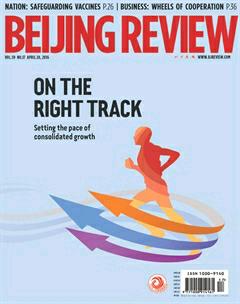Doom and Gloom Prediction Wrong Again
2016-05-04
Given Chinas slowing growth, some people have been predicting that the worlds second largest economy is heading toward a hard fall. In March, rating agencies Moodys and Standard & Poors downgraded the outlook for Chinas credit rating from “stable” to “negative.”But economic data for the first quarter of 2016 issued by the National Bureau of Statistics (NBS) show the country is off to a promising start this year.
According to the data, Chinas GDP grew at a rate of 6.7 percent. While this is lower than the previous quarters 6.8 percent, it is still in the 6.5-7 percent range that the Central Government has set as a reasonable pace for growth. The growth rate of 6.7 percent is relatively high when compared with other major world economies.
More importantly, key economic indicators showed improvements with higher-than-expected growth rates. For example, the industrial added value rose 6.8 percent year on year in March, 1.4 percentage points higher than in the previous two months. Exports were up by 18.7 percent from a year earlier. The producer price index saw a 0.5-percent month-on-month increase, though it is still declining when looked at on a yearon-year basis.
One must take into consideration what has been pushing down the Chinese economy, which includes the impact from the global financial turmoil. But more importantly, the country is conducting a strategic shift in its economic development model in its pursuit of more sustainable growth. China is shuttering a large number of high-polluting and energy-consuming industries and instead lending its support to emerging ones.
This strategic adjustment has already borne fruit. Statistics from the NBS reveal industrial structures continued to improve in the first quarter. The tertiary industry accounted for 56.9 percent of GDP, up 2 percentage points compared with the same period last year. In terms of fixed assets investment, the growth of investment in the hi-tech and service industries outpaced the growth of overall fixed assets investment by about 3 percentage points. In the meantime, the proportion of investment in high energy-consuming sectors keeps declining.
These positive indicators show that 2016, the first year of the 13th Five-Year Plan period (2016-20), is off to a good start and Chinas economy is successfully transitioning.
However, it is now confronted with a series of uncertainties and potential risks. The government should therefore draft targeted and accurate policies and measures to deal with them.
